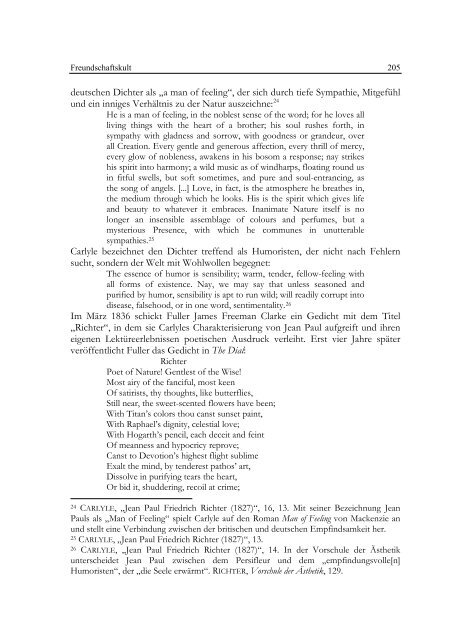Margaret Fullers transnationales Projekt : Selbstbildung, feminine ...
Margaret Fullers transnationales Projekt : Selbstbildung, feminine ...
Margaret Fullers transnationales Projekt : Selbstbildung, feminine ...
Erfolgreiche ePaper selbst erstellen
Machen Sie aus Ihren PDF Publikationen ein blätterbares Flipbook mit unserer einzigartigen Google optimierten e-Paper Software.
Freundschaftskult 205<br />
deutschen Dichter als „a man of feeling“, der sich durch tiefe Sympathie, Mitgefühl<br />
und ein inniges Verhältnis zu der Natur auszeichne: 24<br />
He is a man of feeling, in the noblest sense of the word; for he loves all<br />
living things with the heart of a brother; his soul rushes forth, in<br />
sympathy with gladness and sorrow, with goodness or grandeur, over<br />
all Creation. Every gentle and generous affection, every thrill of mercy,<br />
every glow of nobleness, awakens in his bosom a response; nay strikes<br />
his spirit into harmony; a wild music as of windharps, floating round us<br />
in fitful swells, but soft sometimes, and pure and soul-entrancing, as<br />
the song of angels. [...] Love, in fact, is the atmosphere he breathes in,<br />
the medium through which he looks. His is the spirit which gives life<br />
and beauty to whatever it embraces. Inanimate Nature itself is no<br />
longer an insensible assemblage of colours and perfumes, but a<br />
mysterious Presence, with which he communes in unutterable<br />
sympathies. 25<br />
Carlyle bezeichnet den Dichter treffend als Humoristen, der nicht nach Fehlern<br />
sucht, sondern der Welt mit Wohlwollen begegnet:<br />
The essence of humor is sensibility; warm, tender, fellow-feeling with<br />
all forms of existence. Nay, we may say that unless seasoned and<br />
purified by humor, sensibility is apt to run wild; will readily corrupt into<br />
disease, falsehood, or in one word, sentimentality. 26<br />
Im März 1836 schickt Fuller James Freeman Clarke ein Gedicht mit dem Titel<br />
„Richter“, in dem sie Carlyles Charakterisierung von Jean Paul aufgreift und ihren<br />
eigenen Lektüreerlebnissen poetischen Ausdruck verleiht. Erst vier Jahre später<br />
veröffentlicht Fuller das Gedicht in The Dial:<br />
Richter<br />
Poet of Nature! Gentlest of the Wise!<br />
Most airy of the fanciful, most keen<br />
Of satirists, thy thoughts, like butterflies,<br />
Still near, the sweet-scented flowers have been;<br />
With Titan’s colors thou canst sunset paint,<br />
With Raphael’s dignity, celestial love;<br />
With Hogarth’s pencil, each deceit and feint<br />
Of meanness and hypocricy reprove;<br />
Canst to Devotion’s highest flight sublime<br />
Exalt the mind, by tenderest pathos’ art,<br />
Dissolve in purifying tears the heart,<br />
Or bid it, shuddering, recoil at crime;<br />
24 CARLYLE, „Jean Paul Friedrich Richter (1827)“, 16, 13. Mit seiner Bezeichnung Jean<br />
Pauls als „Man of Feeling“ spielt Carlyle auf den Roman Man of Feeling von Mackenzie an<br />
und stellt eine Verbindung zwischen der britischen und deutschen Empfindsamkeit her.<br />
25 CARLYLE, „Jean Paul Friedrich Richter (1827)“, 13.<br />
26 CARLYLE, „Jean Paul Friedrich Richter (1827)“, 14. In der Vorschule der Ästhetik<br />
unterscheidet Jean Paul zwischen dem Persifleur und dem „empfindungsvolle[n]<br />
Humoristen“, der „die Seele erwärmt“. RICHTER, Vorschule der Ästhetik, 129.

















